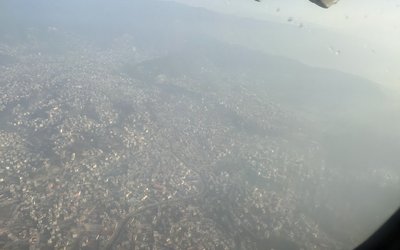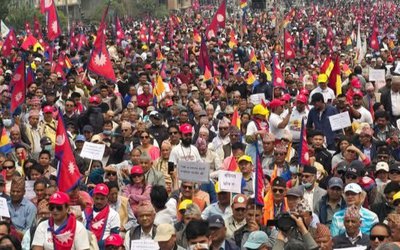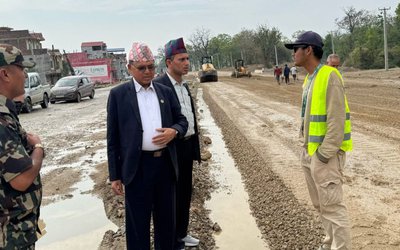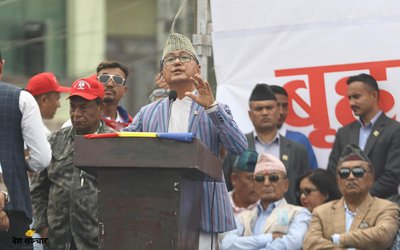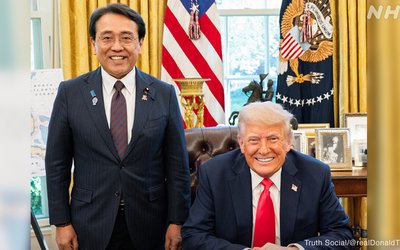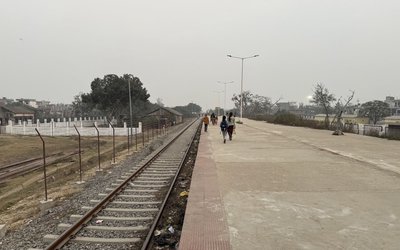Independence Day in the U.S. is traditionally observed on July 4. This is the second year we are celebrating it on President’s Day so we can escape the monsoon weather.
We chose today because it is a United States holiday. We honor the birthdays of two of our great presidents, George Washington and Abraham Lincoln.
Both President Washington and President Lincoln are celebrated because they were passionate advocates for freedom. They believed in a government that represented and served its people.
Washington and Lincoln became presidents because of the Declaration of Independence—a document that Thomas Jefferson wrote two hundred and thirty-nine years ago. Since the Declaration, our path to democracy has not always been easy. My country has endured wars, protests and struggles to define our nation.
Many of you here tonight have heard me say the phrase, “Democracy is tough.” A democracy is always changing, and those changes are often painful and difficult. Nepal is going through this difficult transition right now. This transition can be challenging, as we have all seen. My government is here to support Nepal’s democratic development. We know the way forward has to be a Nepali way forward. The United States, like the rest of the international community, wants to see Nepal prosper as a free and democratic nation where all its citizens receive equal protection and equal opportunity.
My one piece of advice on my last national day in Nepal is another quotation from Abraham Lincoln. He said, “Democracy is the government of the people, by the people, for the people.” I truly believe Nepal has a bright future ahead of it, as long as Nepal’s leaders strive for a democracy that reflects the will of the Nepali people. The United States has been a longtime supporter of the government and the people of Nepal. We are continuing to stand with you as you build your version of democracy. I would now like to share some thoughts on the Nepal-U.S. relationship.
My government has been here for over sixty years. We first worked in Nepal through our development agency, USAID, and then Peace Corps came in the sixties. My country’s interest in Nepal has always been to work with the government to improve the health, education and livelihood of the Nepali people. Over the past 63 years, the United States has provided more than 1.3 billion dollars in development assistance-- using those funds to eradicate malaria, improve health, fight trafficking in persons, and prepare for natural disasters.
I first came to Nepal in 1982. Since then, I’ve seen Nepal achieve remarkable development outcomes. Maternal and infant mortality is down. More girls are going to school than ever before. There is better road, hospital and school infrastructure. A monarchy was replaced with a federal republic committed to greater inclusiveness across all ethnic groups, regions, and castes. Education and employment for women has improved. Awareness about issues affecting women such as human trafficking and gender-based violence has increased.
I have been incredibly lucky to witness Nepal’s development firsthand. Most of you know I’ve served in Nepal three different times. I had to work pretty hard to earn the opportunity to come back. I wanted to return to Nepal for a simple reason—my family and I experienced the famous Nepali warmth and hospitality.
If you look around the event tonight, you will see I am not the only American who has felt this special kinship with Nepal. Many private American citizens have also spent their lives working side by side with Nepalis.
Tonight we have put together an exhibition featuring some of these private American citizens and their contributions to Nepal. I’d like to talk briefly about a few of them.
While trekking in Nepal, Olga Murray realized that she wanted to devote her life to improving education here. In 1990, Olga formed the Nepal Youth Foundation to organize and expand efforts on behalf of Nepali children. In the almost 25 years of its existence, this foundation has impacted the lives of 45 thousand impoverished children in Nepal.
Judith Chase began traveling all over Nepal in 1975, photographing and collecting traditional arts and documenting art techniques. Her collection of these artifacts forms the basis of a cultural heritage museum at Changu Narayan called the Living Traditions Museum. Judith and her husband Jim also founded the Everything Organic Nursery in the hills near Dhulikhel. This nursery is now teaching farmers how to grow new varieties of crops with export potential.
My friend James Giambrone has been protecting and promoting the traditional arts of the Newars for 34 years as the director of the Indigo Gallery. He has documented the work of one of Nepal’s great sculptors, Kuber Singh Shakya, and he has been an integral part in designing permanent exhibitions in the Patan Museum and the Living Traditions Museum at Changu Narayan.
Steve LeCler came to Nepal as a Peace Corps volunteer, and -- like many of those who serve in the Peace Corps in Nepal -- he returned -- and made improving health here his life’s work. His research into Vitamin A deficiency became the basis for the establishment of the Nepal National Vitamin A Program, which today is credited with saving the lives of 20 to 30 thousand children each year. This program is a major factor in reducing child mortality rates in Nepal.
Olga Murray, Judith Chase, James Giambrone and Steve LeCler are just four of the many Americans you may not know who have committed their lives to Nepal and its people. President Abraham Lincoln once said, “Don't worry when you are not recognized, but strive to be worthy of recognition.” People like Olga, Steve, James, and Judith, and also Barbara Adams, Thomas Kelly, Miss Elizabeth Hawley and others here tonight have certainly demonstrated they are worthy of our recognition.
I would also like to say a few words about someone else who is leaving Nepal quite soon--my friend and colleague, the British Ambassador, Andy Sparkes. Andy, you have been a terrific colleague and friend, and you have done a tremendous job in sustaining the historic relationship between the UK and Nepal. You have also been a tireless advocate for individual protections, citizenship rights for all and religious freedom in Nepal. You will be missed by all of us in the diplomatic community.
I will close tonight by acknowledging the terrific Three Marine Expeditionary Force Band that is here with us. They came all the way from Okinawa to help us celebrate Independence Day. Their rendition of Nepal’s national anthem was a strong symbol of the bond between Nepal and the United States. I would also like to thank my household and embassy staff, especially Micah Savidge, for putting together this event.
Peter W. Bodde is an ambassador of the United States of America to Nepal. Excepts of Ambassador Peter W. Bodde Independence Day Speech.
Courtesy: Embassy of the United States of America



